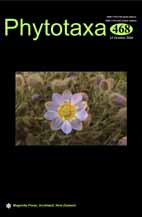Abstract
We have investigated two canal-raphe bearing taxa from two freshwater long-term ecological monitoring sites in the NEON program from Puerto Rico. The identity of these two taxa have been misunderstood, and they have been mistaken for one another, due to being similar in size, shape and having interrupted striae across the valve face. Denticula occidentalis Østrup was described from the U.S. Virgin Islands, and like its congeners has fibulae that extend across the valve face as thickened ribs. The species also has valvocopulae that are typical for the genus, with arched sections that clasp onto the knob-like fibulae. Denticula occidentalis has a discontinuous raphe system, and external proximal raphe ends are hooked towards the valve center and elongated. Grunowia portoricensis, sp. nov. has fibulae restricted to the raphe side of the valve, though unlike most members of the genus the fibulae are knob-like. The raphe is continuous across the central area. Though described here as new to science, the species has been illustrated previously from Venezuela. Distinctions between Nitzschia, Denticula and Grunowia are discussed.

